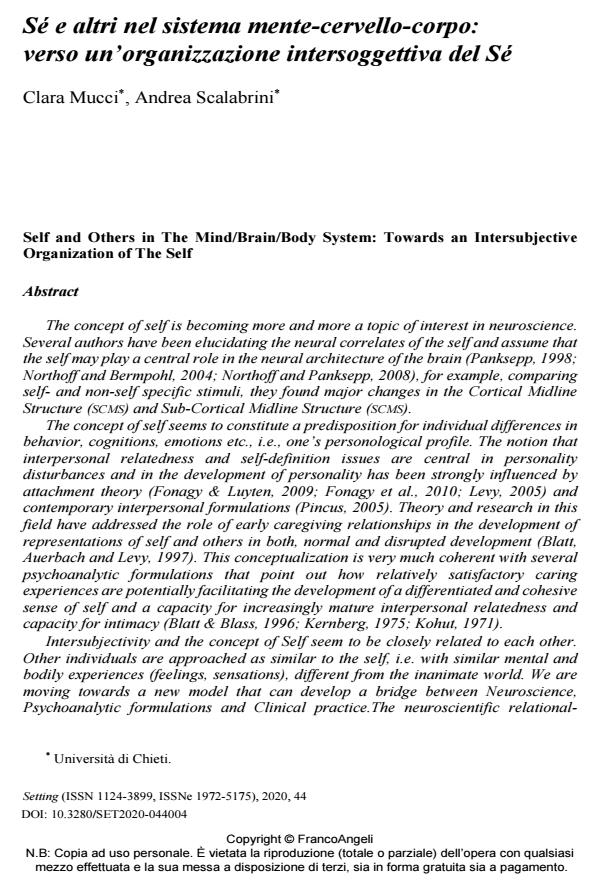Self and Others in The Mind/Brain/Body System: Towards an Intersubjective Organization of The Self
Journal title SETTING
Author/s Clara Mucci, Andrea Scalabrini
Publishing Year 2021 Issue 2020/44
Language Italian Pages 38 P. 79-116 File size 346 KB
DOI 10.3280/SET2020-044004
DOI is like a bar code for intellectual property: to have more infomation
click here
Below, you can see the article first page
If you want to buy this article in PDF format, you can do it, following the instructions to buy download credits

FrancoAngeli is member of Publishers International Linking Association, Inc (PILA), a not-for-profit association which run the CrossRef service enabling links to and from online scholarly content.
The concept of self is becoming more and more a topic of interest in neuroscience. Several authors have been elucidating the neural correlates of the self and assume that the self may play a central role in the neural architecture of the brain (Panksepp, 1998; Northoff and Bermpohl, 2004; Northoff and Panksepp, 2008), for example, comparing self- and non-self specific stimuli, they found major changes in the Cortical Midline Structure (SCMS) and Sub-Cortical Midline Structure (SCMS). The concept of self seems to constitute a predisposition for individual differences in behavior, cognitions, emotions etc., i.e., one’s personological profile. The notion that interpersonal relatedness and self-definition issues are central in personality disturbances and in the development of personality has been strongly influenced by attachment theory (Fonagy & Luyten, 2009; Fonagy et al., 2010; Levy, 2005) and contemporary interpersonal formulations (Pincus, 2005). Theory and research in this field have addressed the role of early caregiving relationships in the development of representations of self and others in both, normal and disrupted development (Blatt, Auerbach and Levy, 1997). This conceptualization is very much coherent with several psychoanalytic formulations that point out how relatively satisfactory caring experiences are potentially facilitating the development of a differentiated and cohesive sense of self and a capacity for increasingly mature interpersonal relatedness and capacity for intimacy (Blatt & Blass, 1996; Kernberg, 1975; Kohut, 1971). Intersubjectivity and the concept of Self seem to be closely related to each other. Other individuals are approached as similar to the self, i.e. with similar mental and bodily experiences (feelings, sensations), different from the inanimate world. We are moving towards a new model that can develop a bridge between Neuroscience, Psychoanalytic formulations and Clinical practice.The neuroscientific relational-constructional concept of the Self and the study of the Resting State Activity in relation to Laboratory tasks can shed a light on the importance of intersubjectivity and intentional attunement (Gallese, Eagle, Migone, 2007) between individuals. We aim to propose our empirical findings on the relation between resting state activity and a laboratory task based on touch (intention to touch a human animate hand vs. a mannequin inanimate hand), given that touch has a privileged status in making possible the social attribution of lived personhood to others. Our results suggest how our brain during resting state seems to be relational by default, it encodes self-awareness necessary to relate with others individuals but not with inanimate objects. Will be discussed how neuroscientific findings have an impact on psychoanalytic concepts releted to clinical practice and how both, the study of Resting State Activity and Task Evoked Activity of the brain can be related to concepts like intentional attunement, empathy and how interaction between different state of the brain/mind can inform clinical practice on Self-Other representations.
Keywords: Self, mind/brain/body system, intersubjectivity
Clara Mucci, Andrea Scalabrini, Sé e altri nel sistema mente-cervello-corpo: verso un’organizzazione intersoggettiva del Sé in "SETTING" 44/2020, pp 79-116, DOI: 10.3280/SET2020-044004